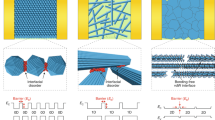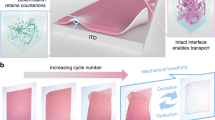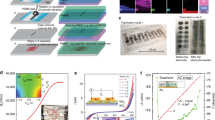Abstract
Thin-film architectures are a staple in a wide range of technologies, such as semiconductor devices, optical coatings, magnetic recording, solar cells and batteries. Despite the industrial success of thin-film technology, mostly due to the easy fabrication and low cost, a fundamental drawback remains: it is challenging to alter the features of the film once fabricated. Here we report a methodology to modify the thickness and sequence of the innermost solid-state thin-film layers. We start with a thin-film stack of amorphous iron oxide and silver. By applying a suitable voltage bias and then reversing it, we can float the silver layer above or below the oxide layer by virtue of the migration of silver atoms. Scanning transmission electron microscopy reveals various sequences and thicknesses of the silver and oxide layers achieved with different experimental conditions. As a proof-of-principle, we show a dynamic change of structural colours of the stack derived from this process. Our results may offer opportunities to dynamically reconfigure thin-film-based functional nanodevices in situ.
This is a preview of subscription content, access via your institution
Access options
Access Nature and 54 other Nature Portfolio journals
Get Nature+, our best-value online-access subscription
$29.99 / 30 days
cancel any time
Subscribe to this journal
Receive 12 print issues and online access
$259.00 per year
only $21.58 per issue
Buy this article
- Purchase on Springer Link
- Instant access to full article PDF
Prices may be subject to local taxes which are calculated during checkout




Similar content being viewed by others
Data availability
The data that support the findings of this study are publicly available at https://doi.org/10.6084/m9.figshare.14060672. Source data are provided with this paper.
Change history
04 May 2022
A Correction to this paper has been published: https://doi.org/10.1038/s41565-022-01128-x
References
Diao, Y. et al. Solution coating of large-area organic semiconductor thin films with aligned single-crystalline domains. Nat. Mater. 12, 665–671 (2013).
Kats, M. A., Blanchard, R., Genevet, P. & Capasso, F. Nanometre optical coatings based on strong interference effects in highly absorbing media. Nat. Mater. 12, 20–24 (2013).
Xi, J.-Q. et al. Optical thin-film materials with low refractive index for broadband elimination of Fresnel reflection. Nat. Photon. 1, 176–179 (2007).
Ramesh, R. & Spaldin, N. A. Multiferroics: progress and prospects in thin films. Nat. Mater. 6, 21–29 (2007).
Green, M. A. Thin-film solar cells: review of materials, technologies and commercial status. J. Mater. Sci. Mater. Electron. 18, 15–19 (2007).
Zheng, X. et al. Managing grains and interfaces via ligand anchoring enables 22.3%-efficiency inverted perovskite solar cells. Nat. Energy 5, 131–140 (2020).
Hou, Y. et al. Efficient tandem solar cells with solution-processed perovskite on textured crystalline silicon. Science 367, 1135–1140 (2020).
Liu, J. et al. Pathways for practical high-energy long-cycling lithium metal batteries. Nat. Energy 4, 180–186 (2019).
Tan, D. H., Banerjee, A., Chen, Z. & Meng, Y. S. From nanoscale interface characterization to sustainable energy storage using all-solid-state batteries. Nat. Nanotechnol. 15, 170–180 (2020).
Brongersma, M. L. Introductory lecture: nanoplasmonics. Faraday Discuss. 178, 9–36 (2015).
Lin, D., Fan, P., Hasman, E. & Brongersma, M. L. Dielectric gradient metasurface optical elements. Science 345, 298–302 (2014).
Kong, B., Selomulya, C., Zheng, G. & Zhao, D. New faces of porous Prussian blue: interfacial assembly of integrated hetero-structures for sensing applications. Chem. Soc. Rev. 44, 7997–8018 (2015).
Nogueira, G. M., Banerjee, D., Cohen, R. E. & Rubner, M. F. Spray-layer-by-layer assembly can more rapidly produce optical-quality multistack heterostructures. Langmuir 27, 7860–7867 (2011).
Yang, D., Ye, S. & Ge, J. From metastable colloidal crystalline arrays to fast responsive mechanochromic photonic gels: an organic gel for deformation‐based display panels. Adv. Funct. Mater. 24, 3197–3205 (2014).
Kim, J. B. et al. Wrinkles and deep folds as photonic structures in photovoltaics. Nat. Photon. 6, 327–332 (2012).
Park, W. & Lee, J.-B. Mechanically tunable photonic crystal structure. Appl. Phys. Lett. 85, 4845–4847 (2004).
Snoswell, D. R. et al. Shear ordering in polymer photonic crystals. Phys. Rev. E 81, 020401 (2010).
Tse, W.-K. & MacDonald, A. H. Giant magneto-optical Kerr effect and universal Faraday effect in thin-film topological insulators. Phys. Rev. Lett. 105, 057401 (2010).
Kim, H. et al. Structural colour printing using a magnetically tunable and lithographically fixable photonic crystal. Nat. Photon. 3, 534–540 (2009).
Yan, C. et al. Stretchable and wearable electrochromic devices. ACS Nano 8, 316–322 (2014).
Liu, Y. et al. Structural colour three-dimensional printing by shrinking photonic crystals. Nat. Commun. 10, 4340 (2019).
Luo, C., Narayanaswamy, A., Chen, G. & Joannopoulos, J. Thermal radiation from photonic crystals: a direct calculation. Phys. Rev. Lett. 93, 213905 (2004).
Ito, M. M. et al. Structural colour using organized microfibrillation in glassy polymer films. Nature 570, 363–367 (2019).
Lee, H. S., Shim, T. S., Hwang, H., Yang, S.-M. & Kim, S.-H. Colloidal photonic crystals toward structural colour palettes for security materials. Chem. Mater. 25, 2684–2690 (2013).
Gupta, T. D. et al. Self-assembly of nanostructured glass metasurfaces via templated fluid instabilities. Nat. Nanotechnol. 14, 320–327 (2019).
Duan, X., Kamin, S. & Liu, N. Dynamic plasmonic colour display. Nat. Commun. 8, 14606 (2017).
Huang, M. T. et al. Voltage-gated optics and plasmonics enabled by solid-state proton pumping. Nat. Commun. 10, 5030 (2019).
Ríos, C., Hosseini, P., Taylor, R. A. & Bhaskaran, H. Colour depth modulation and resolution in phase-change material nanodisplays. Adv. Mater. 28, 4720–4726 (2016).
Hosseini, P., Wright, C. D. & Bhaskaran, H. An optoelectronic framework enabled by low-dimensional phase-change films. Nature 511, 206–211 (2014).
Dong, W. et al. Wide bandgap phase change material tuned visible photonics. Adv. Funct. Mater. 29, 1806181 (2018).
Zhu, X., Vannahme, C., Højlund-Nielsen, E., Mortensen, N. A. & Kristensen, A. Plasmonic colour laser printing. Nat. Nanotechnol. 11, 325–329 (2016).
Zhu, X., Yan, W., Levy, U., Mortensen, N. A. & Kristensen, A. Resonant laser printing of structural colours on high-index dielectric metasurfaces. Sci. Adv. 3, e1602487 (2017).
Kim, T.-H. et al. Full-colour quantum dot displays fabricated by transfer printing. Nat. Photon. 5, 176–182 (2011).
Kristensen, A. et al. Plasmonic colour generation. Nat. Rev. Mater. 2, 16088 (2017).
Vlasov, Y. A., Bo, X.-Z., Sturm, J. C. & Norris, D. J. On-chip natural assembly of silicon photonic bandgap crystals. Nature 414, 289–293 (2001).
Zhou, Y. et al. Thin-film Sb2Se3 photovoltaics with oriented one-dimensional ribbons and benign grain boundaries. Nat. Photon. 9, 409–415 (2015).
Oh, Y. et al. Plasmonic periodic nanodot arrays via laser interference lithography for organic photovoltaic cells with >10% efficiency. ACS Nano 10, 10143–10151 (2016).
Jolly Bose, R. et al. Effect of silver incorporation in phase formation and band gap tuning of tungsten oxide thin films. J. Appl. Phys. 112, 114311 (2012).
Mathew, M. et al. Anomalous behavior of silver doped indium sulfide thin films. J. Appl. Phys. 100, 033504 (2006).
Yamashita, T. & Hayes, P. Analysis of XPS spectra of Fe2+ and Fe3+ ions in oxide materials. Appl. Surf. Sci. 254, 2441–2449 (2008).
Acknowledgements
R.Z. acknowledges the support from National Key R&D Program of China 2018YFE0200200. C.-W.Q. acknowledges the support from the National Research Foundation, Prime Minister’s Office, Singapore, under Competitive Research Program (Award NRF-CRP22-2019-0006). C.W.Q is also supported by the grant (R-261-518-004-720) from Advanced Research an Technology Innovation Center (ARTIC) and the grant (R-263-000-E55-305) from A*STAR under the Advanced Manufacturing and Engineering (AME) Individual Research Grant (IRG), under no. A2083c0060. We acknowledge the support from Park Systems Pte Ltd, C. Lee and S. R. Wang for assistance with the nanopixel imaging demonstration. We sincerely thank B. Tai., W. He. and L. B. Cheng for their useful discussion during the initial period of this work. We thank L. Song. for the discussion of device design, and Y. S. Tan for his kind assistance during the device fabrication.
Author information
Authors and Affiliations
Contributions
R.Z., C.-W.Q. and Z.Y. conceived the idea. Z.Y. designed this work under the guidance of C.-W.Q., R.Z. and C.T.C. Z.Y. fabricated the devices and measured the optical spectra. Reflectivity simulations were conducted by Z.Y. and S.S. Park Systems Pte Ltd and Z.Y. performed the demonstration of nanopixel imaging. Z.Z. performed the XPS characterization and analysis. The microstructure characterization was conducted by Z.Y. with advice from X.J. W.W. did the density functional theory calculations. Z.Y., R.Z. and C.-W.Q. wrote the paper with inputs from all the co-authors. C.-W.Q. and R.Z. supervised the project. All the authors discussed the results and contributed to the manuscript.
Corresponding authors
Ethics declarations
Competing interests
The authors disclose a submitted patent application on a related structure altering of solid-sate thin films reported in this article, Singapore Patent application number 10201912602P filed in January 2020. The patent applicant is the Singapore University of Technology and Design. The inventors are Z.Y. and the co-authors R.Z. and X.J. All other authors declare no other competing interests.
Additional information
Peer review information Nature Nanotechnology thanks the anonymous reviewers for their contribution to the peer review of this work.
Publisher’s note Springer Nature remains neutral with regard to jurisdictional claims in published maps and institutional affiliations.
Supplementary information
Supplementary Information
Supplementary Figs. 1–14 and Notes.
Supplementary Data
Numerical and raw data.
Source data
Source Data Fig. 2
Raw data of Fig. 2a, Fig. 2c, Fig. 2e, Fig. 2f and Fig. 2g
Source Data Fig. 4
Raw data of Fig. 4e.
Rights and permissions
About this article
Cite this article
Yan, Z., Zhang, Z., Wu, W. et al. Floating solid-state thin films with dynamic structural colour. Nat. Nanotechnol. 16, 795–801 (2021). https://doi.org/10.1038/s41565-021-00883-7
Received:
Accepted:
Published:
Issue Date:
DOI: https://doi.org/10.1038/s41565-021-00883-7
This article is cited by
-
Active electrochemical high-contrast gratings as on/off switchable and color tunable pixels
Nature Communications (2022)
-
Memristors get the hues
Nature Nanotechnology (2021)



